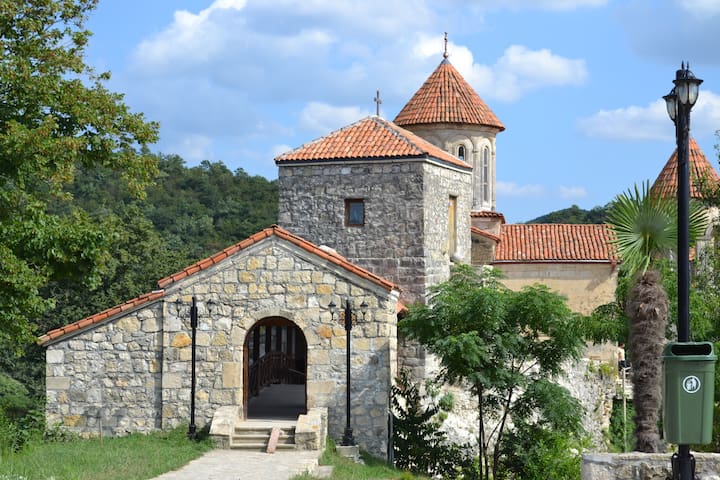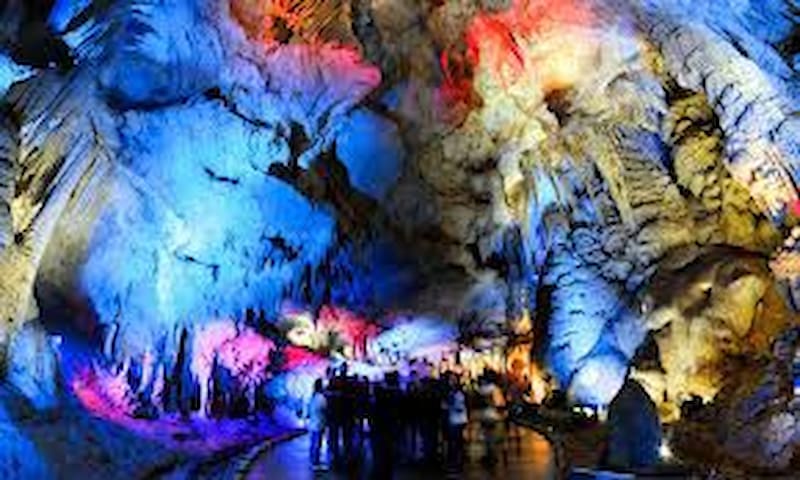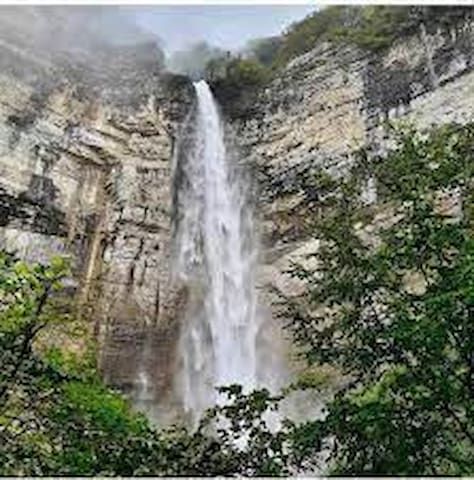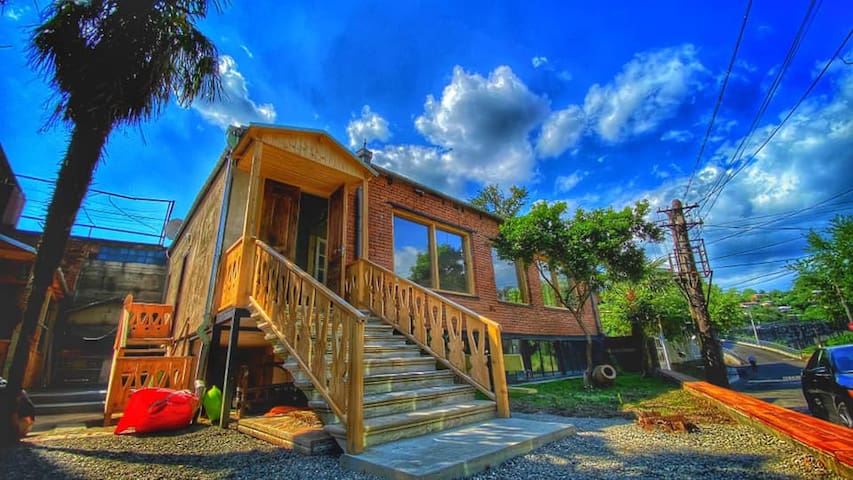Sightseeing
The Cathedral of the Dormition, or the Kutaisi Cathedral, more commonly known as Bagrati Cathedral (Georgian: ბაგრატი; ბაგრატის ტაძარი, or Bagratis tadzari), is an 11th-century cathedral in the city of Kutaisi, in the Imereti region of Georgia. A masterpiece of the medieval Georgian architecture, the cathedral suffered heavy damage throughout centuries and was reconstructed to its present state through a gradual process starting in the 1950s, with controversial conservation works concluding in 2012. These works prompted UNESCO to remove the Cathedral from its list of World Heritage sites. A distinct landmark in the scenery of central Kutaisi, the cathedral rests on the Ukimerioni Hill.
In July 2010 UNESCO added Bagrati cathedral to its list of endangered world heritage sites in part because of the continuing reconstruction, which it feared would affect the structural integrity and authenticity of the site.[2] Even before the reconstruction works, in 2008 ICOMOS was concerned about the deteriorating state of Bagrati, but it commended that any conservation efforts by the Government should not include a type of reconstruction which would affect the site's historical value.[3] In 2011 UNESCO urged the Georgian government authorities to develop a rehabilitation strategy that would reverse some of the changes made to the site in recent years, but it acknowledged that these alterations may be "almost irreversible".[4] In 2013, architect Andrea Bruno was awarded a Georgian state gold medal for his role in the Bagrati Cathedral reconstruction and was subsequently recognized for this project with the University of Ferrara Domus International Prize for Restoration and Conservation.[5][6] UNESCO removed Bagrati Cathedral from its World Heritage sites in 2017, considering its major reconstruction detrimental to its integrity and authenticity.[7]
63 personas locales recomiendan
Bagrati Cathedral
Bagrati StreetThe Cathedral of the Dormition, or the Kutaisi Cathedral, more commonly known as Bagrati Cathedral (Georgian: ბაგრატი; ბაგრატის ტაძარი, or Bagratis tadzari), is an 11th-century cathedral in the city of Kutaisi, in the Imereti region of Georgia. A masterpiece of the medieval Georgian architecture, the cathedral suffered heavy damage throughout centuries and was reconstructed to its present state through a gradual process starting in the 1950s, with controversial conservation works concluding in 2012. These works prompted UNESCO to remove the Cathedral from its list of World Heritage sites. A distinct landmark in the scenery of central Kutaisi, the cathedral rests on the Ukimerioni Hill.
In July 2010 UNESCO added Bagrati cathedral to its list of endangered world heritage sites in part because of the continuing reconstruction, which it feared would affect the structural integrity and authenticity of the site.[2] Even before the reconstruction works, in 2008 ICOMOS was concerned about the deteriorating state of Bagrati, but it commended that any conservation efforts by the Government should not include a type of reconstruction which would affect the site's historical value.[3] In 2011 UNESCO urged the Georgian government authorities to develop a rehabilitation strategy that would reverse some of the changes made to the site in recent years, but it acknowledged that these alterations may be "almost irreversible".[4] In 2013, architect Andrea Bruno was awarded a Georgian state gold medal for his role in the Bagrati Cathedral reconstruction and was subsequently recognized for this project with the University of Ferrara Domus International Prize for Restoration and Conservation.[5][6] UNESCO removed Bagrati Cathedral from its World Heritage sites in 2017, considering its major reconstruction detrimental to its integrity and authenticity.[7]
Motsameta (Georgian: მოწამეთა) also known as Motsameta monastery is a complex of monasteries at the Imereti region, approximately 6 km northeast of the center of Kutaisi, Georgia. The monastery is picturesquely located on the cliff of a promontory in the curve of the Ckalcitela river, a tributary of the Rioni river.[1]
Its name, whose meaning is the "Place of the Martyrs", is related to the brothers of a noble family of Argveti, David and Constantine, who organized a rebellion against the occupying Arabs in the 8th century.[2]
When the rebellion failed, they were captured and then they were promised forgiveness in exchange for converting to Islam. None accepted the offer, and they were later tortured and killed, and their bodies were thrown into the river. The water turned red and in memory of this event, the river was called Ckalcitela, which means red water. According to the story, the brothers' remains were captured by the lions and taken to the hill,[3] where the Gelati monastery is located. Later, the Orthodox Church of Georgia recognized them as Saints, and in the 11th century, the king Bagrat IV of Georgia founded a temple there.[2][3] Officials from the Bolshevik secret police in 1923 took the remains of David and Constantine from the Gelati monastery to the museum in Kutaisi, but this caused such a scandal that the relics were delivered quickly and are still in the monasteries today.[4] According to legend, there is a secret passage between the Motsameta monasteries and the Gelati monastery, used during the wars.
36 personas locales recomiendan
Motsameta Monastery
Motsameta (Georgian: მოწამეთა) also known as Motsameta monastery is a complex of monasteries at the Imereti region, approximately 6 km northeast of the center of Kutaisi, Georgia. The monastery is picturesquely located on the cliff of a promontory in the curve of the Ckalcitela river, a tributary of the Rioni river.[1]
Its name, whose meaning is the "Place of the Martyrs", is related to the brothers of a noble family of Argveti, David and Constantine, who organized a rebellion against the occupying Arabs in the 8th century.[2]
When the rebellion failed, they were captured and then they were promised forgiveness in exchange for converting to Islam. None accepted the offer, and they were later tortured and killed, and their bodies were thrown into the river. The water turned red and in memory of this event, the river was called Ckalcitela, which means red water. According to the story, the brothers' remains were captured by the lions and taken to the hill,[3] where the Gelati monastery is located. Later, the Orthodox Church of Georgia recognized them as Saints, and in the 11th century, the king Bagrat IV of Georgia founded a temple there.[2][3] Officials from the Bolshevik secret police in 1923 took the remains of David and Constantine from the Gelati monastery to the museum in Kutaisi, but this caused such a scandal that the relics were delivered quickly and are still in the monasteries today.[4] According to legend, there is a secret passage between the Motsameta monasteries and the Gelati monastery, used during the wars.
Gelati (Georgian: გელათის მონასტერი) is a medieval monastic complex near Kutaisi in the Imereti region of western Georgia. One of the first monasteries in Georgia,[2] it was founded in 1106 by King David IV of Georgia as a monastic and educational center, and is recognized by UNESCO as a World Heritage Site.[3]
The monastery is an exemplar of the Georgian Golden Age and a gold aesthetic is employed in the paintings and buildings.[4] It was built to celebrate Orthodox Christian faith in Georgia.[5] Some murals found inside the Gelati Monastery church date back as early as the 12th century.[6]
Historically, Gelati was a cultural and intellectual center in Georgia. It had an Academy that employed Georgian scientists, theologians and philosophers, many of whom had previously been active at various Orthodox monasteries abroad, such as the Mangana Monastery in Constantinople.[7] Among its notable scholars were Ioane Petritsi, who translated several classics of philosophy but is best known for his commentaries on Proclus; and Arsen Ikaltoeli, known for his Dogmatikon, or book of teachings, influenced by Aristotle. The Gelati Academy employed scribes to compile manuscript copies of important works,[8] and people of the time called it "a new Hellas" and "a second Athos".[9]
The monastery is located on a hill 13 kilometres to the northeast of Kutaisi. It also overlooks the Tskaltsitela Gorge.
The Gelati Monastery was built in 1106 by King David IV of Georgia, at which time Kutaisi was the capital of Georgia.[8] It was constructed during the reign of the Byzantine Empire; in this period Christianity was the ruling religion throughout the empire. The monastery's main church, known as Church of Virgin the Blessed was dedicated to Virgin Mary. The monastery was also constructed to function as an academy of science and education in Georgia.[8]
Today
The monastery is still active and its churches continue to be regularly used for religious service. Under the supervision of UNESCO the site is being continually restored and protected. All the original structures of the monastery are intact and functional.
The mosaics and murals were damaged prior to UNESCO conservation,[11] but halted when the roof of the academy building was replaced by Georgian conservators.[8] By presidential decree, the monastery was added to the National Register of Monuments for protection and restoration in 2006.
Triptychs
Triptychs were popular during the Byzantine Empire and important in Georgian culture.[12] The triptychs represented another form of contribution to the church. Triptychs were a form of iconography for the congregation.
Mosaics
The interiors of the monastery hold mosaics in classic Byzantine style illustrating aspects of Christian belief. The largest, a 12th-century masterpiece depicting the Virgin Mary holding the baby Jesus, dominates the apse of the main church, and is an artwork of cultural importance in Georgia.[13] Above the altar is situated a statue of the Virgin Mary, looking down at the baby Jesus she is holding.
The Gelati monastery is constructed of solid stone, with full archways. The plan of the main monastery was designed in the shape of a cross, the symbol of Jesus's crucifixion and of Christianity.[14] The monastery was designed to be visible over much of the country, with its stone walls constructed to reflect sunlight. There are archways throughout the monastery, including the bell tower.
59 personas locales recomiendan
Gelati Monastery
Road to Gelati MonasteryGelati (Georgian: გელათის მონასტერი) is a medieval monastic complex near Kutaisi in the Imereti region of western Georgia. One of the first monasteries in Georgia,[2] it was founded in 1106 by King David IV of Georgia as a monastic and educational center, and is recognized by UNESCO as a World Heritage Site.[3]
The monastery is an exemplar of the Georgian Golden Age and a gold aesthetic is employed in the paintings and buildings.[4] It was built to celebrate Orthodox Christian faith in Georgia.[5] Some murals found inside the Gelati Monastery church date back as early as the 12th century.[6]
Historically, Gelati was a cultural and intellectual center in Georgia. It had an Academy that employed Georgian scientists, theologians and philosophers, many of whom had previously been active at various Orthodox monasteries abroad, such as the Mangana Monastery in Constantinople.[7] Among its notable scholars were Ioane Petritsi, who translated several classics of philosophy but is best known for his commentaries on Proclus; and Arsen Ikaltoeli, known for his Dogmatikon, or book of teachings, influenced by Aristotle. The Gelati Academy employed scribes to compile manuscript copies of important works,[8] and people of the time called it "a new Hellas" and "a second Athos".[9]
The monastery is located on a hill 13 kilometres to the northeast of Kutaisi. It also overlooks the Tskaltsitela Gorge.
The Gelati Monastery was built in 1106 by King David IV of Georgia, at which time Kutaisi was the capital of Georgia.[8] It was constructed during the reign of the Byzantine Empire; in this period Christianity was the ruling religion throughout the empire. The monastery's main church, known as Church of Virgin the Blessed was dedicated to Virgin Mary. The monastery was also constructed to function as an academy of science and education in Georgia.[8]
Today
The monastery is still active and its churches continue to be regularly used for religious service. Under the supervision of UNESCO the site is being continually restored and protected. All the original structures of the monastery are intact and functional.
The mosaics and murals were damaged prior to UNESCO conservation,[11] but halted when the roof of the academy building was replaced by Georgian conservators.[8] By presidential decree, the monastery was added to the National Register of Monuments for protection and restoration in 2006.
Triptychs
Triptychs were popular during the Byzantine Empire and important in Georgian culture.[12] The triptychs represented another form of contribution to the church. Triptychs were a form of iconography for the congregation.
Mosaics
The interiors of the monastery hold mosaics in classic Byzantine style illustrating aspects of Christian belief. The largest, a 12th-century masterpiece depicting the Virgin Mary holding the baby Jesus, dominates the apse of the main church, and is an artwork of cultural importance in Georgia.[13] Above the altar is situated a statue of the Virgin Mary, looking down at the baby Jesus she is holding.
The Gelati monastery is constructed of solid stone, with full archways. The plan of the main monastery was designed in the shape of a cross, the symbol of Jesus's crucifixion and of Christianity.[14] The monastery was designed to be visible over much of the country, with its stone walls constructed to reflect sunlight. There are archways throughout the monastery, including the bell tower.
The Kutaisi synagogue is one of three synagogues in Kutaisi in the Republic of Georgia.
The synagogue was built in 1885 and it is located at the Gaponov Street 57–59. The other synagogues, located at Gaponov Street 8 and Gaponov Street 10, are 160 years old.
Synagogue
Boris Gaponov StreetThe Kutaisi synagogue is one of three synagogues in Kutaisi in the Republic of Georgia.
The synagogue was built in 1885 and it is located at the Gaponov Street 57–59. The other synagogues, located at Gaponov Street 8 and Gaponov Street 10, are 160 years old.
Sataplia Strict Nature Reserve (Georgian: სათაფლია სახელმწიფო ნაკრძალი ) is located 10 km from town of Kutaisi in Imereti region of Georgia.[1] Visitors center is located in village lower Alvani, Akhmeta Municipality at the slopes of extinct volcano — Mount Sataplia. The name Sataplia can be freely translated as a "honey place" (In Georgian language თაფლი, tapli means honey. ) and in fact bees used to live in small holes and caves and honey was harvested by the local population.
Sataplia Strict Nature Reserve is part of Imereti Caves Protected Areas, which also includes Sataplia Managed Reserve, Prometheus Cave Natural Monument.[2]
History
The Natural Park Sataplia was founded in 1935 to protect recently discovered karst cave with exotic stalactites and stalagmites as well Colchian forest, geological and archaeological sites. Park was expanded to it present borders in 1957. In 2010 and 2011 the Sataplia Managed Reserve was developed to accommodate tourists: visitor center was built, a coffee house in the middle of the park, a small museum, a small park with dinosaur models and glass observation deck built above the cliff. Furthermore, the main karst cave was equipped with lighting effects and a secure footpath.
Geography
Of the total area of 350 ha, 348 ha are covered with forests. Relief of the landscape is mountainous. The reservation features a crater of an extinct volcano, a site of remains of a man of the Stone Age and fossilized traces of dinosaurs. The largest cave of Sataplia was discovered in 1925 and is about 900 m long.
Sataplia Managed Reserve (Georgian: სათაფლიას აღკვეთილი) is a protected area and tourist attraction in Akhmeta Municipality in Imereti region of Georgia, 10 km from town of Kutaisi.[1] Visitors center is located in village lower Alvani at the slopes of extinct volcano — Mount Sataplia. The name Sataplia can be freely translated as a "honey place" (In Georgian language თაფლი , tapli means honey. ) and in fact bees used to live in small holes and caves and honey was harvested by the local population.
49 personas locales recomiendan
Sataplia Cave and Nature Reserve
M111Sataplia Strict Nature Reserve (Georgian: სათაფლია სახელმწიფო ნაკრძალი ) is located 10 km from town of Kutaisi in Imereti region of Georgia.[1] Visitors center is located in village lower Alvani, Akhmeta Municipality at the slopes of extinct volcano — Mount Sataplia. The name Sataplia can be freely translated as a "honey place" (In Georgian language თაფლი, tapli means honey. ) and in fact bees used to live in small holes and caves and honey was harvested by the local population.
Sataplia Strict Nature Reserve is part of Imereti Caves Protected Areas, which also includes Sataplia Managed Reserve, Prometheus Cave Natural Monument.[2]
History
The Natural Park Sataplia was founded in 1935 to protect recently discovered karst cave with exotic stalactites and stalagmites as well Colchian forest, geological and archaeological sites. Park was expanded to it present borders in 1957. In 2010 and 2011 the Sataplia Managed Reserve was developed to accommodate tourists: visitor center was built, a coffee house in the middle of the park, a small museum, a small park with dinosaur models and glass observation deck built above the cliff. Furthermore, the main karst cave was equipped with lighting effects and a secure footpath.
Geography
Of the total area of 350 ha, 348 ha are covered with forests. Relief of the landscape is mountainous. The reservation features a crater of an extinct volcano, a site of remains of a man of the Stone Age and fossilized traces of dinosaurs. The largest cave of Sataplia was discovered in 1925 and is about 900 m long.
Sataplia Managed Reserve (Georgian: სათაფლიას აღკვეთილი) is a protected area and tourist attraction in Akhmeta Municipality in Imereti region of Georgia, 10 km from town of Kutaisi.[1] Visitors center is located in village lower Alvani at the slopes of extinct volcano — Mount Sataplia. The name Sataplia can be freely translated as a "honey place" (In Georgian language თაფლი , tapli means honey. ) and in fact bees used to live in small holes and caves and honey was harvested by the local population.
Prometheus Cave may regard as the visit card of Georgia. The magic cave is full with stunning curtains of stalactites and stalagmites. While visiting, once again it will convince you about existence of the fairy world.
Prometheus Cave is located in Tskaltubo municipality, village Kumistavi. River. There are 22 halls found, where just 6 halls are open for tourists. It is possible to walk through the length of 1420 meters in the cave's territory visit the halls and enjoy boat tour by walking the river. Discover real masterpieces of nature - stalactites and stalagmites at Prometheus Cave, which are the most beautiful forms created by nature. While visiting the cave, hanging waterfalls are waiting for you. Be more adventurous and spend your weekend in a beautiful and special area – Western Georgia.
56 personas locales recomiendan
Prometheus Cave
Prometheus Cave may regard as the visit card of Georgia. The magic cave is full with stunning curtains of stalactites and stalagmites. While visiting, once again it will convince you about existence of the fairy world.
Prometheus Cave is located in Tskaltubo municipality, village Kumistavi. River. There are 22 halls found, where just 6 halls are open for tourists. It is possible to walk through the length of 1420 meters in the cave's territory visit the halls and enjoy boat tour by walking the river. Discover real masterpieces of nature - stalactites and stalagmites at Prometheus Cave, which are the most beautiful forms created by nature. While visiting the cave, hanging waterfalls are waiting for you. Be more adventurous and spend your weekend in a beautiful and special area – Western Georgia.
OKATSE (KINCHKHA) WATERFALL
Okatse (Kinchkha) Waterfall is located in Khoni municipality of Imereti region, close to the village Kinchkha. It is three-step waterfall cascade in the river gorge of Satsikvilo. Flows from Eastern part of massive chalk stone slopes. Waterfall is distinguished by its geomorphologic construction. From the upper steps, the water falls from 25m and from 70m heights into the flatland, where huge siphons are formed. After joining the small rivers, descents a third, 20 meters -high waterfall.
It is possible to visit waterfall by marked trails, beside the fact that on the territory infrastructure was not arranged, it was discovered by many visitors and was in the favourite travel destination list. Make your trip more adventurous and do not postpone to visit this amazing place.
16 personas locales recomiendan
Kinchkha Waterfall
Kinchkha-Kinchkhaferdi RoadOKATSE (KINCHKHA) WATERFALL
Okatse (Kinchkha) Waterfall is located in Khoni municipality of Imereti region, close to the village Kinchkha. It is three-step waterfall cascade in the river gorge of Satsikvilo. Flows from Eastern part of massive chalk stone slopes. Waterfall is distinguished by its geomorphologic construction. From the upper steps, the water falls from 25m and from 70m heights into the flatland, where huge siphons are formed. After joining the small rivers, descents a third, 20 meters -high waterfall.
It is possible to visit waterfall by marked trails, beside the fact that on the territory infrastructure was not arranged, it was discovered by many visitors and was in the favourite travel destination list. Make your trip more adventurous and do not postpone to visit this amazing place.
Rioni River
book in advance entertainment activities like rafting or kaiaking
Food scene
💫ამბობენ, რომ ბარაქას ეთნო სივრცეში კერძებსაც კი, განსხვავებული გემო აქვთ
🌸გაზაფხულის მოსვლასთან ერთად, ჩვენი ეზო კიდევ უფრო მრავალფეროვანი გახდა
🏠იმერული ოდა
🔥ბუხრიანი დიდი მარანი
🏡ღია ფაცხა
🍷ქვევრებიანი მარანი
🍇საწნახელის სივრცე
🥘ცხელი კეცებით მორთმეული ბარაქას უნიკალური კერძები სწორედ აქ უნდა დააგემოვნოთ!
13 personas locales recomiendan
ბარაქა/Baraqa
7 Tamar Mepe St💫ამბობენ, რომ ბარაქას ეთნო სივრცეში კერძებსაც კი, განსხვავებული გემო აქვთ
🌸გაზაფხულის მოსვლასთან ერთად, ჩვენი ეზო კიდევ უფრო მრავალფეროვანი გახდა
🏠იმერული ოდა
🔥ბუხრიანი დიდი მარანი
🏡ღია ფაცხა
🍷ქვევრებიანი მარანი
🍇საწნახელის სივრცე
🥘ცხელი კეცებით მორთმეული ბარაქას უნიკალური კერძები სწორედ აქ უნდა დააგემოვნოთ!
აქ ცხოვრობს ღვინო! Wine lives here!
Here you can taste natural wines made by small wine-making companies and traditional Georgian dishes from all the parts of our country.
ქართული ტრადიციული მეღვინეობის რჩეული ღვინოების გამოფენა - წარმოდგენილია უძველესი ქართული მეთოდოლოგიით დაყენებული საუკეთესო ღვინოები საქართველოს ყველა რეგიონიდან.
ქართული ღვინოების გამოფენა, დეგუსტაცია, პრეზენტაცია, დაგემოვნება, გაყიდვა.
ღვინის ბარი - საღამოს 20 საათიდან ფორტეპიანოს საამო ჰანგების თანხლებით.
ქართული ტრადიციული პროდუქტების გამოფენა-გაყიდვა - ყველეული, ჩირეული, ჩურჩხელები, თაფლი, საკმაზები და სხვ.
სუვენირების და ხელოვნების სხვადასხვა ნაკეთობების გამოფენა-გაყიდვა.
ღვინის ტურები.
8 personas locales recomiendan
Satsnakheli Wine Bar
7 Nikitin stაქ ცხოვრობს ღვინო! Wine lives here!
Here you can taste natural wines made by small wine-making companies and traditional Georgian dishes from all the parts of our country.
ქართული ტრადიციული მეღვინეობის რჩეული ღვინოების გამოფენა - წარმოდგენილია უძველესი ქართული მეთოდოლოგიით დაყენებული საუკეთესო ღვინოები საქართველოს ყველა რეგიონიდან.
ქართული ღვინოების გამოფენა, დეგუსტაცია, პრეზენტაცია, დაგემოვნება, გაყიდვა.
ღვინის ბარი - საღამოს 20 საათიდან ფორტეპიანოს საამო ჰანგების თანხლებით.
ქართული ტრადიციული პროდუქტების გამოფენა-გაყიდვა - ყველეული, ჩირეული, ჩურჩხელები, თაფლი, საკმაზები და სხვ.
სუვენირების და ხელოვნების სხვადასხვა ნაკეთობების გამოფენა-გაყიდვა.
ღვინის ტურები.









